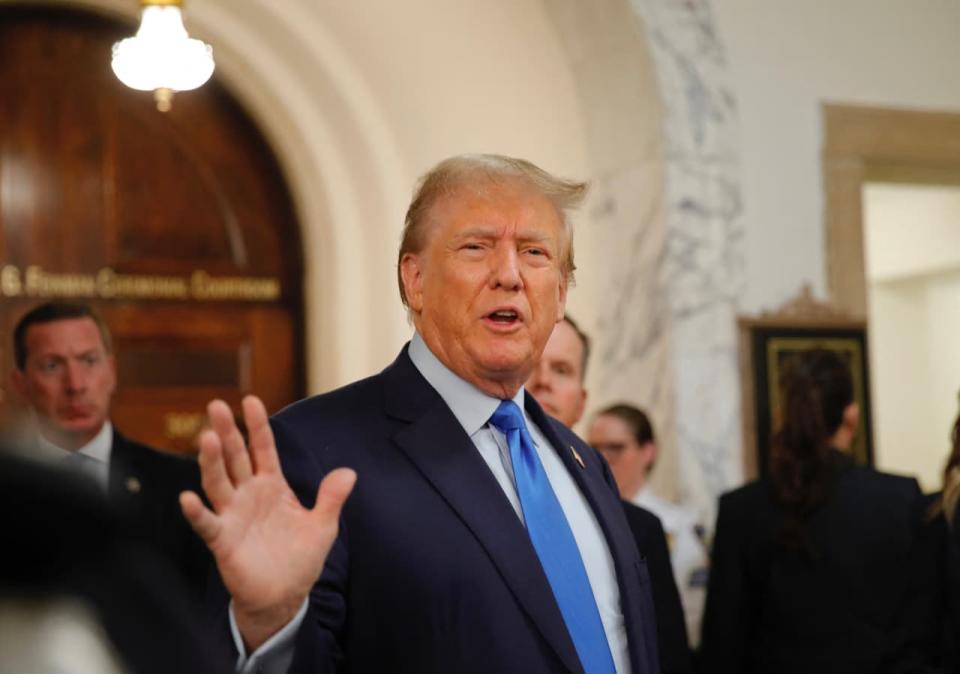
Shares of Trump Media & Technology Group Corp. have fallen since they began trading last week with former President Donald Trump’s initials as the ticker symbol — but don’t blame short sellers for any further weakness.
Most Read from MarketWatch
If the social-media platform’s stock DJT keeps falling, it will be because of selling by former bulls who are now getting out of their investments, according to Ihor Dusaniwsky, managing director of financial analytics at S3 Partners. That’s because there aren’t many shares available to short, and the cost to make a bearish bet can be prohibitive.
Trump Media shares were down 3.5% in afternoon trading Wednesday to trade below the $49.95 level where they closed on March 25 — the day before the ticker symbol changed to “DJT” from “DWAC” following the company’s merger with a special-purpose acquisition company, or SPAC, an instrument also known as a blank-check company.
The stock had initially soared as much as 58.9% to an intraday high of $79.38 on March 26 before pulling back to close that day up 16.1%, at $57.99. Since then, it has shed 14.1%.
Read: Trump’s DJT stock trades at multiples that exceed the peak of the meme-stock era
To short a stock — the act of selling a stock without ever owning it, on the expectation it can be bought back later at a lower price — that stock first has to be borrowed from someone who does own it and is willing and able to lend it. The fewer shares there are available to borrow, the higher the cost to borrow them. (Read more about the mechanics behind a short sale here.)
“There is very little stock available to borrow to support new short selling — less than 50,000 shares — and with demand to short this stock extremely high, we are seeing stock-borrow rates at 500% to 600% fee levels,” Dusaniwsky told MarketWatch on Tuesday.
Based on that data, to short 100 shares of Trump Media & Technology Group at the current price, it would cost between $24,895 and $29,874 a year. That means the stock would have to fall about 1.4% a day just to cover the cost of shorting it. And if the short were held for a year, the bet would still lose about $20,000 to $25,000, even if the stock price fell to $1.
Basically, you, as the short-selling investor, can be very right and still lose a lot of money.
Given the cost and the fact that there are “no sizable stock borrows available to support new short sales,” Dusaniwsky said he believes “there can be no new selling pressure brought on by short sellers.”
Therefore, he said, any further weakness in the stock price will be driven by selling among “longs,” or investors who had previously bought the stock.
Read: Trump’s net worth takes a $1 billion hit after DJT stock plunge
Through Tuesday, short interest in both the DJT and DWAC listings — the number of shares that have been bought as part of a bet that prices will fall — was at 4.93 million shares, or 12.6% of the shares available for the public to trade, according to data provided by Dusaniwsky. But those bears have been losing money so far.
Dusaniwsky estimated that DJT short bets had about $42 million in mark-to-market profits over the first two trading sessions in April — but that is after losses of about $126 million in March.
MarketWatch data: These are the most shorted stocks on the market
He added that there is a some scope for a “short squeeze,” which is a panic-like scramble to cover short positions that leads to surge in a stock’s price, especially if prices start rising.
“Mark-to-market losses and extremely expensive stock-borrow costs are a Mike Tyson–like combination blow to short sellers, which have them wobbly but not quite counted out of this fight,” Dusaniwsky said.
Most Read from MarketWatch
Source: finance.yahoo.com
